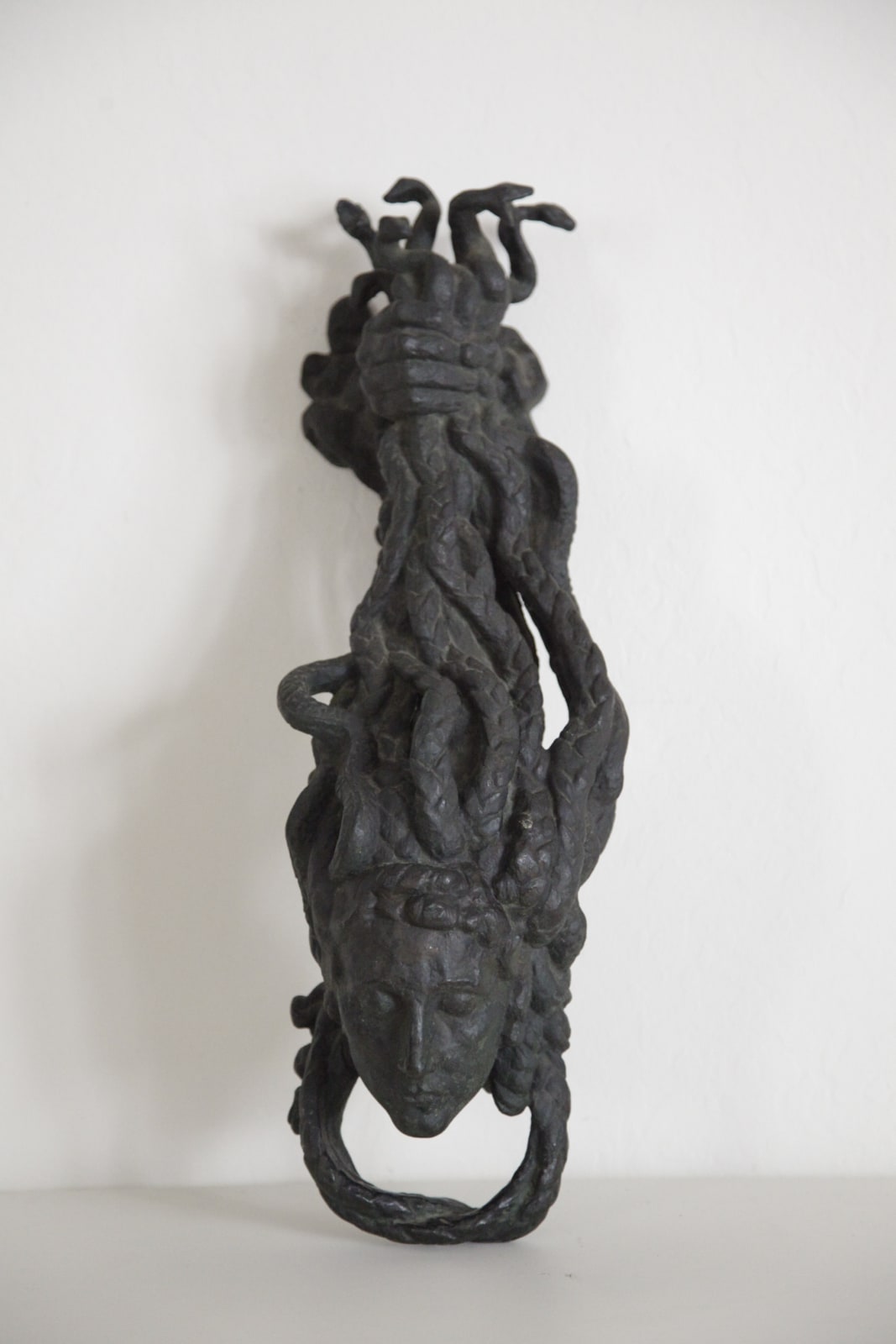







Emile Antoine Bourdelle (1861-1929)
Door Knocker in Form of Medusa , Circa 1925
bronze
22”(h) X 8” X 7-1/2”
Further images
-
(View a larger image of thumbnail 1
)

-
(View a larger image of thumbnail 2
)

-
(View a larger image of thumbnail 3
)

-
(View a larger image of thumbnail 4
)

-
(View a larger image of thumbnail 5
)

-
(View a larger image of thumbnail 6
)

-
(View a larger image of thumbnail 7
)

-
(View a larger image of thumbnail 8
)

According to an ancient Greek myth, a young hero named Perseus was ordered by an evil king to slay Medusa. This was a most challenging task, since he dared not...
According to an ancient Greek myth, a young hero named Perseus was ordered by an evil king to slay Medusa. This was a most challenging task, since he dared not look in her direction else he turn to stone. He could, however, focus attention on his polished shield, which reflected her image like a mirror. Taking careful aim, Perseus swung his sword and swiftly cut off the monster’s head. In Bourdelle’s bronze, we see Perseus’s hand grasping Medusa’s head by her long braids. He will cover the head with a bag and present it to the evil king, who will open the bag, take one look, and turn to stone.
Emile-Antoine Bourdelle created this bronze sculpture of Medusa’s head in the form of a doorknocker the size of an actual head. Yet instead of fashioning Medusa as a grotesque monster, he gave her an exquisitely beautiful, serene face and sinuous braids that writhe into snakes in Perseus’s hand. Below Medusa’s chin, two braids extend from ear to ear, forming the doorknocker’s handle. By lifting Medusa’s human-scale head with the handle, visitors could knock on the door, announcing their arrival. While it would not turn them to stone, this doorknocker would have certainly created an imposing first impression.
In a modern home, especially one with a door unfit to hang such a heavy fixture, one can fasten this knocker to the wall to be appreciated simply as a sculpture. The tension between its passionate, violent form and the placid expression on Medusa’s face are perhaps more noticeable this way. The sculpture contains multiplicities of emotion; it is an unexpectedly versatile object that will change its tone with shifting light and environment.
About the Artist
Emile-Antoine Bourdelle was a French sculptor whose works existed at the transition point between the Beaux Arts and Modernist styles. A student of Auguste Rodin and a teacher of sculptors such as Alberto Giacometti and Henri Matisse, Bourdelle’s influence pervades through some of the most significant figures in art’s recent history. His own style demonstrated the rugged textural expression of his mentor Rodin, yet broke away into more classical forms and mythological themes in his later years.
Emile-Antoine Bourdelle created this bronze sculpture of Medusa’s head in the form of a doorknocker the size of an actual head. Yet instead of fashioning Medusa as a grotesque monster, he gave her an exquisitely beautiful, serene face and sinuous braids that writhe into snakes in Perseus’s hand. Below Medusa’s chin, two braids extend from ear to ear, forming the doorknocker’s handle. By lifting Medusa’s human-scale head with the handle, visitors could knock on the door, announcing their arrival. While it would not turn them to stone, this doorknocker would have certainly created an imposing first impression.
In a modern home, especially one with a door unfit to hang such a heavy fixture, one can fasten this knocker to the wall to be appreciated simply as a sculpture. The tension between its passionate, violent form and the placid expression on Medusa’s face are perhaps more noticeable this way. The sculpture contains multiplicities of emotion; it is an unexpectedly versatile object that will change its tone with shifting light and environment.
About the Artist
Emile-Antoine Bourdelle was a French sculptor whose works existed at the transition point between the Beaux Arts and Modernist styles. A student of Auguste Rodin and a teacher of sculptors such as Alberto Giacometti and Henri Matisse, Bourdelle’s influence pervades through some of the most significant figures in art’s recent history. His own style demonstrated the rugged textural expression of his mentor Rodin, yet broke away into more classical forms and mythological themes in his later years.
Provenance
This sculpture was acquired from the artist by Mr. Takanaga Mitsui. It was then passed on to Mr. Takanobu Mitsui, then to Yorikatsu Mitsui, and finally to his wife Misako Mitsui, the present owner.Signup for our Newsletter
You will receive two emails a month from us. One introduces artworks and design works from Kyoto's hidden sources and the other is stories from Misako, sharing insights into Japanese culture.
* denotes required fields
为了回应您的查询,我们将根据我们的隐私政策处理您提供的个人数据。